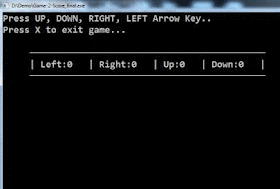Following C program demonstrate how to maintain score in a Game. Score of respective arrow key press event will be increased by one on every arrow key press event.
#include <stdio.h>
#include <windows.h>
COORD c = {0, 0};
void setxy (int x, int y)
{
c.X = x; c.Y = y; // Set X and Y coordinates
SetConsoleCursorPosition(GetStdHandle(STD_OUTPUT_HANDLE), c);
}
int main()
{
int i, j, x=25, y=10, ch1, ch2;
int score_x1=5, score_y1=4, up=1, down=1, right=1, left=1;
printf("Press UP, DOWN, RIGHT, LEFT Arrow Key..\n");
printf("Press X to exit game... \n");
setxy(5,3); //Top border line...
for(i=0; i<44; i++)
printf("%c", 196);
setxy(5,5);//Bottom border line...
for(i=0; i<44; i++)
printf("%c", 196);
//Verticle lines
setxy(5,4);
printf("| Left:0 | Right:0 | Up:0 | Down:0 |");
ch1 = getch();
ch2 = 0;
//When accepting arrow key, function must be called twice; first call returns 0/0xE0; second call returns actual key code
if (ch1 == 0xE0)
{
setxy(x,y);
while(ch2 != 'X')
{
ch2 = getch();
switch(ch2)
{
case 72: //Up
setxy(x,--y);
printf("%c",2);
setxy(score_x1+28,score_y1);
printf("%d",up++);
break;
case 80: //Down
setxy(x,++y);
printf("%c",2);
setxy(score_x1+39,score_y1);
printf("%d",down++);
break;
case 75: //Left
setxy(--x,y);
printf("%c",2);
setxy(score_x1+7,score_y1);
printf("%d",left++);
break;
case 77: //Right
setxy(++x,y);
printf("%c",2);
setxy(score_x1+19,score_y1);
printf("%d",right++); break;
default: break;
}
}
}
return 0;
}
//Design and developed by cprogrampracticals.blogspot.in
 |
| Fig.: Game Score Management |

